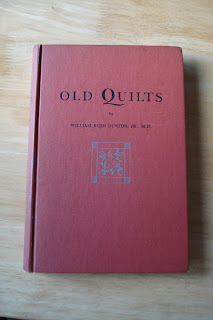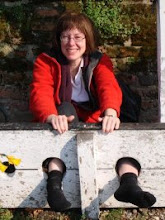Here is an item that I bought in November on that well known auction site. It is a blanket with a story and was sold to me as a Red Cross Army Blanket.
The blanket is very worn and has many holes. It is made of knitted bands where the colours change every 6 or 7 inches. It looks as if these bands are made of odds and ends of knitting wool. The bands are joined together with a herringbone stitch and then a tape is stitched onto the back over the join. The best feature of the blanket is the large red cross which makes it very graphic in appearance.
The blanket is wery worn and has many holes - and there are darns and patches as well.
Here you can see the stitching that joins the bands together. There is a red binding also, although this is coming off. The blanket obviously had a special significance for the family, to be kept so long, and the seller put this on the item:
"Hi this is an odd one. 4 ft x 4ft approx wool knit blanket. This is more to do with war memorabilia but a small story, this was carried off a hospital ship during the second world war by my grandfather who had been injured in service. The blanket is wool and was made by nuns at the time. Its quite heavy and has a few holes in it but still has a use somewhere. Incidentally, my grandfather died of his injuries."
I have been in touch with Maxine M (also on the BQSG committee with me) and when I asked if I could donate the blanket to the Red Cross Quilt Study Group I am pleased to say she said yes. The group has at least two exhibitions coming up in 2013 and I am hoping that the red cross on this blanket might be of use in those. Another member of the group lives here in Woodbridge so it will not be difficult to hand over.





















































